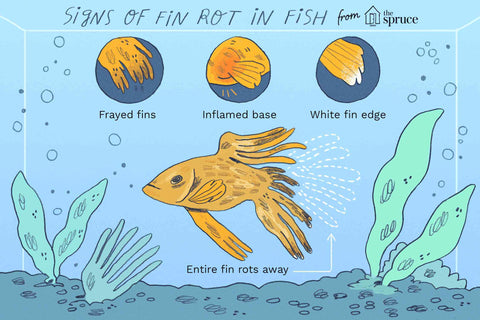There are lots of great reasons to opt for a home aquarium if you’re considering getting a fish. Aquariums take up minimal space if you are pinched for room at home. Watching a fish tank can reduce your stress level as they come in all colors, shapes, and sizes. Also, some people are allergic to cats and dogs, so fish provide an alternative option.

But like any other pet, fish can become sick too. So you need to know common disease symptoms in fish. Knowing what to look out for means preventative measures can be taken to keep your fish healthy and happy.
Sick Fish, Sick Owners?
Believe it or not, fish carry germs that can make people sick. Those germs can spread when you come in contact with the aquarium during or after after cleaning it, or after feeding your fish.
Some common diseases that can pass from an aquarium to humans include:
- Aeromonas – A bacteria that can cause diarrhea or blood infections
- Mycobacterium marinum – This comes from contaminated water, and can lead to skin infections
- Salmonella – Salmonella can cause diarrhea, vomiting, fever, or abdominal cramps in humans
- Streptococcus iniae – This bacteria can result in a skin infection at the site of open cuts or scrapes
Additionally, keep an eye on your fish to watch out for these five common parasites and diseases.
Ich

Ich is short for Ichthyophthirius multifiliis, also known as white spot disease. Common symptoms include the appearance of small, raised lesions that appear to be blisters along the body wall and/or the fins. No white spots will be present when the infection is isolated to a fish’s gills.
The gills will look swollen and be covered with a thick mucus. An ich infection will also show signs of the parasite on the skin, fins, or gills. An ich outbreak in your aquarium can be brought on by poor water quality, and can produce a rapid mortality rate.
We recommend using Cupramine to treat ich in your tank. Another effective way to help combat Ich is to increase the water temperature. The Cupramine medicine will only kill the parasites in their larval state but by increasing the water temperature, the parasites' life cycle will speed up, thus exposing the parasites to the medicine much faster.
Flukes

Known scientifically as Monogenean trematodes, another name for flukes are flatworms. They invade a fish’s skin, fins, and gills. An adult fluke can permanently hitch itself to one spot on the host fish.
Fish that are infected with flukes will swim near the water surface, appear lethargic, lose their appetite, and swim near the sides of their aquarium. Their skin can also suffer scale loss and ooze a pinkish fluid. Additionally, their gills can appear pale and swollen.
Treatment of a fluke infestation typically isn’t effective unless the primary source is minimized. Formalin and/or Paraguard is the ideal treatment for flukes found in freshwater fish.
Anchor Worms

Anchor worms, or Lernaea, are common among goldfish and koi. The host fish becomes incapacitated from infection once a female anchor worm the fish’s skin. Formalin is also a treatment option for anchor worms.
Fin Rot

Like the name says, this bacterial disease can eat away at a fish's fins. An overcrowded or unsanitary tank tends to be the culprit for a fin rot outbreak. Treatment options include improving tank water quality, antibiotics, or medicated food.
Ammonia Poisoning
Ammonia levels in a tank can rise to unsafe levels when there is insufficient beneficial bacteria. Your fish probably has ammonia poisoning if their gills are red and inflamed. They also might be gasping for air at the tank’s surface. You can treat this issue by improving your tank's water quality. Use a gravel vacuum to do so.

Visit Pets on Broadway to keep your fish swimmingly healthy. While there, pick up our parasitic and bacterial water treatment liquids. We offer several treatment options to cure what ails your fish and aquarium including the following:
-
MetroPlex, a safe and effective treatment option for bacterial diseases of fish such as Cryptocaryon, Hexamita, and Ichthyophthirius. You can mix it with medicated food to treat parasites in tanks that contain invertebrates.

- ParaGuard, which is a both fish and filter safe aldehyde based parasite control product. It's effective at treating Ich and Fin Rot.
- Cupramine contains copper—an ideal treatment method for tanks without invertebrates. Use Cupramine to treat Anchor Worms and Ich.
Fish make great pets. But just like any other pet owner, you need to prioritize their health and happiness. That means monitoring them for signs of disease and illness. In doing so, you'll also keep your household healthy too.
Worried about a possible illness in a goldfish? We recommend checking the below image to see if your goldfish may be displaying any signs of illness.

General Reminders When Treating Fish Tanks
Friendly reminder here to always remove any carbon that may remain in the tank. Many medicine instructions fail to mention the importance of removing carbon before inputting medicine treatments. Carbon binds to the medications making the treatment less effective.


